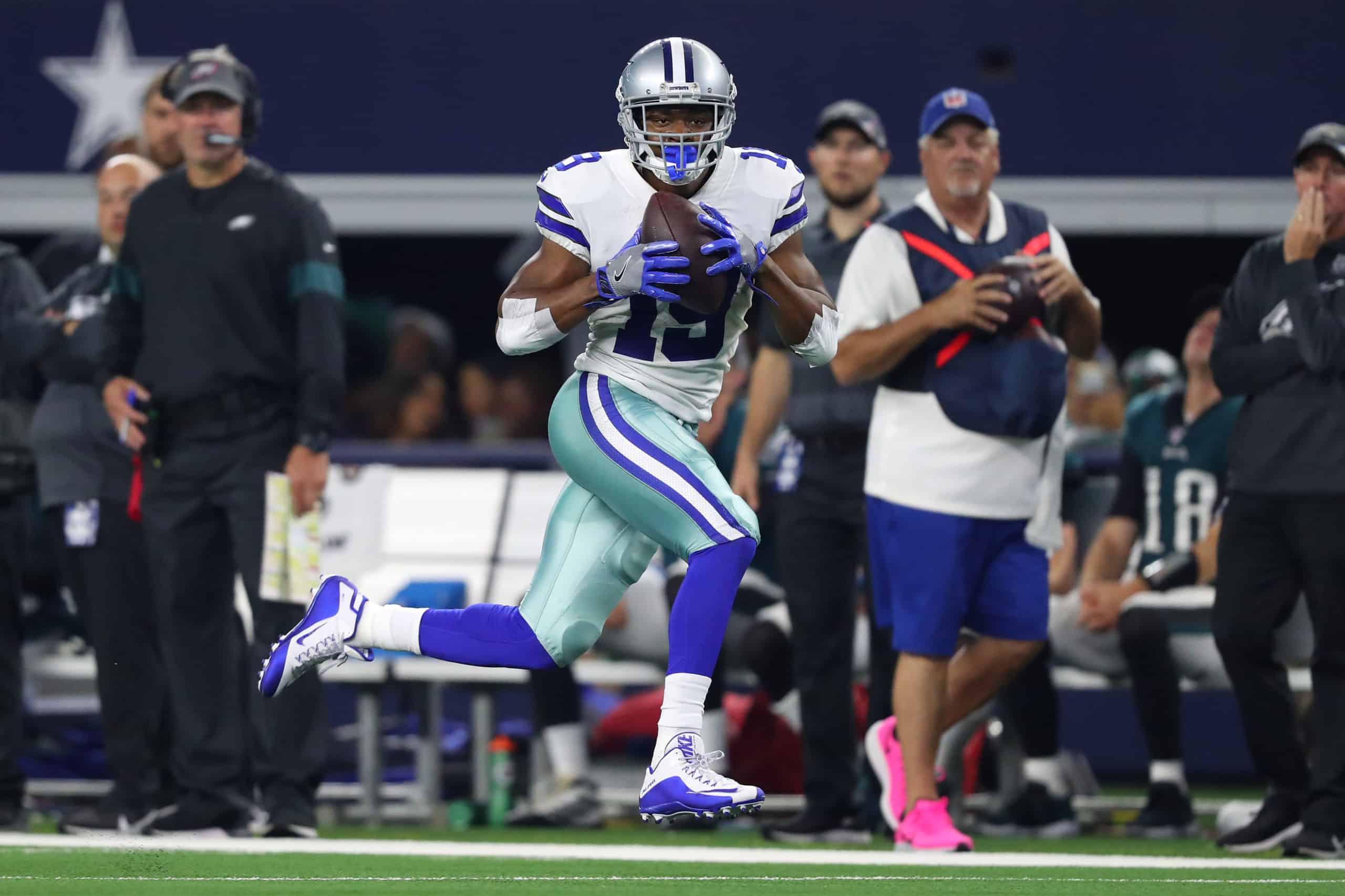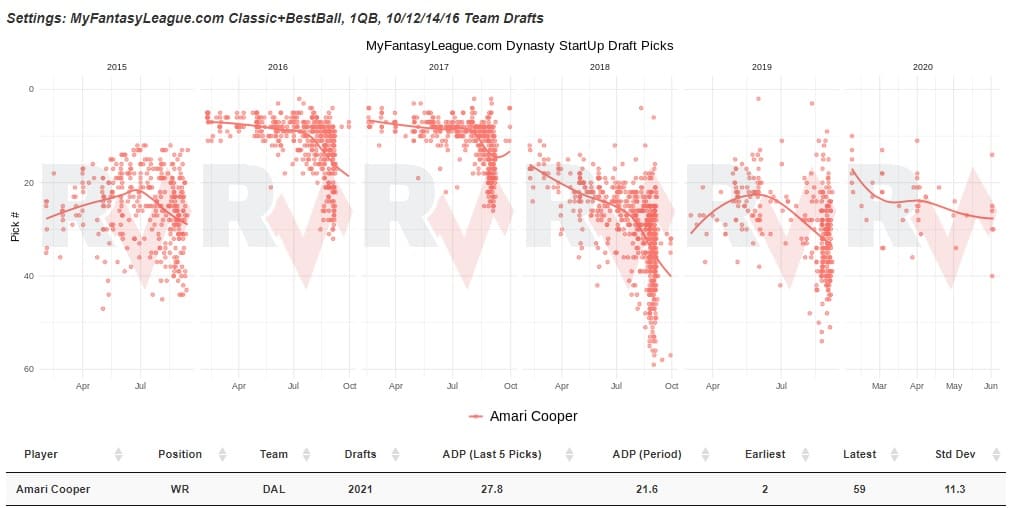Now that free agency, the NFL Draft, and the schedule release have all passed, we have our initial layout in place in team depth charts and strength of schedule. With that, we want to take a look at some players across the fantasy landscape that are either polarizing, over or undervalued, or just interesting topics of discussion and walk through some pros and cons of where those players are regarded in fantasy circles.
So far we have explored players such as Kenyan Drake, Austin Ekeler, Marquise Brown, Tyler Higbee, Mecole Hardman, Nick Chubb, the trio of DeVante Parker, Preston Williams and Mike Gesicki , D.J. Chark, Odell Beckham, Aaron Jones, and Leonard Fournette. For this installment, we are digging into Amari Cooper.
Week 1 Age: 26.2
Contract: Signed through 2024 (potential out year after 2021)
Using the Dynasty ADP app available at RotoViz, Cooper has gone from a fringe first-rounder to a third-rounder over the past three seasons, but has regained some value this offseason by signing a five-year contract extension with the Cowboys.
As discussed with Odell Beckham last week, wide receivers changing teams tend to immediately decline. But Cooper hit the ground running in Dallas after a midseason trade in 2018, while rolling that strong close to that season over into 2019 when he was the WR10 in overall PPR scoring and the WR15 in points per game (15.4 points). Showing synergy with Dak Prescott, Cooper staying in Dallas for potentially the remainder of his age apex is a strong benefit to his fantasy potential.
Amari Cooper Career Splits Per Team
| Team | Gm | Tgt/Gm | Rec/Gm | ReYd/Gm | Yd/Rec | Yd/Tgt | TD | Catch% | TD/Tgt% | PPR PPG |
|---|---|---|---|---|---|---|---|---|---|---|
| OAK | 53 | 7.5 | 4.3 | 60.2 | 14.1 | 8 | 19 | 56.9% | 4.8% | 12.5 |
| DAL | 27 | 7.9 | 5.4 | 77.6 | 14.4 | 9.8 | 15 | 68.1% | 7.0% | 16.4 |
Maintaining similar volume per game to what he received in Oakland, Cooper’s marriage to Prescott has been much more efficient across the board, lifting all of his receiving output.
One of the career knocks on Cooper has been that he has been a hyper-volatile commodity, producing high spike weeks, but having a lower fantasy floor than some of his peers at cost at the position. In 27 career games with the Cowboys, he has been held to fewer than 50 receiving yards 11 times with fewer than 40 yards in nine of those games.
He also has some funky home/road splits with the Cowboys. In 14 games at home with Dallas, Cooper has caught 94-of-119 targets (78.9%) for 1,525 yards (16.2 Y/R) and 11 touchdowns (22.2 PPR points per game) as opposed to catching 51-of-94 targets (54.3%) for 559 yards (10.9 Y/R) and four touchdowns (10.2 points per game) in 13 road games. His highest yardage total on the road with Dallas is 83 yards, reaching 50 yards receiving in just four of those games. Home and away splits are largely noise and filled with variance, but those splits are so wonky that they are at least interesting enough to mention.
2019 Game Log
| Week | Opp | H/A | Snap% | Tgt | Tgt% | Rec | ReYd | ReTD | PPR | WR Rank |
|---|---|---|---|---|---|---|---|---|---|---|
| 1 | NYG | H | 76.5% | 9 | 28.1% | 6 | 106 | 1 | 22.6 | 16 |
| 2 | WAS | @ | 91.4% | 5 | 16.7% | 4 | 44 | 1 | 14.4 | 30 |
| 3 | MIA | H | 84.7% | 7 | 21.9% | 6 | 88 | 2 | 26.8 | 7 |
| 4 | NO | @ | 96.6% | 8 | 24.2% | 5 | 48 | 0 | 9.8 | 34 |
| 5 | GB | H | 87.5% | 14 | 31.8% | 11 | 226 | 1 | 39.6 | 3 |
| 6 | NYJ | @ | 3.7% | 2 | 5.0% | 1 | 3 | 0 | 1.3 | 94 |
| 7 | PHI | H | 80.0% | 5 | 18.5% | 5 | 106 | 0 | 15.6 | 17 |
| 9 | NYG | @ | 85.9% | 7 | 20.0% | 4 | 80 | 1 | 18 | 13 |
| 10 | MIN | H | 88.7% | 14 | 29.8% | 11 | 147 | 1 | 31.7 | 4 |
| 11 | DET | @ | 55.4% | 8 | 17.4% | 3 | 38 | 0 | 6.8 | 54 |
| 12 | NE | @ | 81.2% | 2 | 6.1% | 0 | 0 | 0 | 0 | 97 |
| 13 | BUF | H | 82.1% | 11 | 22.4% | 8 | 85 | 0 | 16.5 | 22 |
| 14 | CHI | @ | 78.1% | 8 | 16.3% | 6 | 83 | 1 | 20.3 | 11 |
| 15 | LAR | H | 71.4% | 2 | 8.7% | 1 | 19 | 0 | 2.9 | 86 |
| 16 | PHI | @ | 74.2% | 12 | 27.3% | 4 | 24 | 0 | 6.4 | 55 |
| 17 | WAS | H | 82.7% | 5 | 15.2% | 4 | 92 | 0 | 13.8 | 28 |
Cooper’s volatility and odd home/away production was present in 2019. Over the opening 10 weeks of the season, Cooper was the WR4 in overall scoring, but he struggled to close the season and dealt with a knee injury that limited his practice time and reduced his snap share a bit. Cooper’s high snap share from Weeks 11-17 was 82.7% after eclipsing that number in six of his opening nine games of the season. Over that span, Cooper was the WR43 in overall scoring (66.7 points) and was outscored by both teammates Michael Gallup (108.7) and Randall Cobb (74.8) while being out-targeted by Gallup 57-48.
Outside of injuries, performance, Gallup’s emergence, Cooper also had some scoring regression. After scoring four times over the first three weeks, Cooper found the end zone just four more times for the remainder of the season.
Part of Cooper's volatility is tethered to his touchdown output because he has had to work hard for his touchdowns. Of Cooper’s 34 career receiving touchdowns, 21 of them have come from outside of the red zone and just six have come from inside of the 10-yard line. The average length of Cooper's touchdown receptions over his career has been 33.5 yards. With Dallas, that is 31.0 yards, with just two of his 15 touchdown receptions coming from inside the 10-yard line.
Over the past five years, 66.5% of all passing touchdowns in the league have come from inside of the red zone with 42.1% occurring from inside of the 10-yard line. The positive news is that Cooper did lead Dallas with nine end zone targets a year ago, catching five for scores, but even his end zone targets are coming from further out.
The final element in play for Cooper’s volatility is that he has regularly struggled against high-end cornerbacks and press coverage. In five games last season facing Tre’Davious White, Darius Slay, Stephon Gilmore, Jalen Ramsey, and Marshon Lattimore, Cooper combined to catch 17-of-31 targets for 190 yards and zero touchdowns, catching 10-of-21 targets for 114 yards in the coverage of those cornerbacks. Beating press and man coverage has been a consistent thorn for Cooper outside of 2019.
Some Amari Cooper #ReceptionPerception notes:
– Never scored higher than the 71st percentile in success rate vs. man coverage
– That's actually gone down through his career.
– Has finished below the 22nd percentile vs. press in 2 of his last 3 seasons.(more to follow) pic.twitter.com/RXKz0U28WQ
— Matt Harmon (@MattHarmon_BYB) April 3, 2020
But it’s here where I circle back to Cooper’s upside. With Dallas selecting CeeDee Lamb in the first round this spring and letting Randall Cobb leave via free agency, it gives Dallas full offensive flexibility to use all of their wideouts in a more versatile fashion. Cobb was restricted as a slot only option, playing 91.9% of his snaps there in 2019. Lamb himself has some slot experience, playing 26% of senior season snaps from the inside and I would wager the rookie leads the Cowboys wideouts in slot snaps in 2020. But his experience lining up outside gives Dallas the potential to free up their entire offense by having players that can win inside and outside.
Since joining the Cowboys, Cooper has run just 14.8% of his routes from the slot after a 20% slot rate with the Raiders. In the slot for the Cowboys, Cooper has averaged 17.4 yards per reception and 2.7 yards per route run. Adding versatility to the game of their lead wideout gives the offense and Cooper an extra gear to win in an area he has excelled on his opportunities while giving him more free releases and facing less press and man coverage with potentially the added bonus of being shadowed by some of those high-caliber defensive backs.
Amari Cooper Career Rate Stats Inside vs Out
| Alignment | Route % | Tgt/Rt% | Catch% | Yd/Rec | Yd/Route | TD% |
|---|---|---|---|---|---|---|
| Slot | 18.1% | 26.4% | 67.2% | 13.4 | 2.4 | 7.0% |
| Outside | 81.9% | 19.6% | 63.0% | 14.6 | 1.8 | 5.6% |
Now, it needs to be clear that Cooper will not be a regular slot player and it takes some rational coaching investment to increase his usage there, but even getting him back to the 20-plus percent range inside can raise his floor and ceiling.
Bringing this home, I have solid WR2 expectations for Cooper in 2020 with added upside for more if Dallas can increase his slot use to free him up versus tight coverage and if his weird home/road splits finally even out. But his uneven play and lack of getting over on quality cornerbacks prevents him from being in the WR1 bucket. For Dynasty, I am just about in line with the field at WR13. Turning just 26 years old next week, Cooper is still a touch younger than a number of his cohorts in wide receiver cost such as Stefon Diggs, Kenny Golladay, Cooper Kupp, Keenan Allen, and Allen Robinson to name a few, while he has attachment to the best long term fantasy quarterback of that grouping.
As usual in closing here, in dynasty, every player has potential to be both a buy and sell at the same time. You just have to find the proper context in your league on which he is valued per owner. Startup ADP and cost is not going to be an exact market for you with team context a driving force in established leagues, but here are the buy and sell point suggestions using that as guideline pending which side you fall on.
2020 Rookie Pick Value: Early-Mid First (1.04-1.05)
RB Value Targets: Austin Ekeler, Aaron Jones, Leonard Fournette
WR Value Targets: Odell Beckham, Kenny Golladay, Allen Robinson
TE Value Targets: Travis Kelce
Be sure to pick up a copy of Warren Sharp's new book: 2020 Football Preview, available for pre-sale now with an early-bird special price!
This book shares insights into the players, coaches, teams and philosophies with one goal in mind: to get you prepared for the 2020 season by delivering the smartest information in the fastest, most direct way possible for optimal reviewing and retention.

















